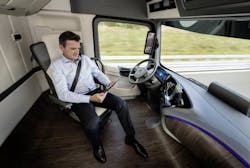So insurance giant State Farm recently conducted an online survey of about 1,000 U.S. consumers aged 18 or older regarding their “attitudes” towards autonomous vehicles (AVs) – and what behaviors they might engage in if driving wasn’t a primary responsibility when behind the wheel.
This is also a follow-on poll of sorts as State Farm conducted a similar survey three years ago; thus it’s designed in part to see if there’s been any significant “shift” in attitudes towards self-driving technology.
In a word, yes; significant shifts are indeed occurring, especially in terms of overall “awareness” of AV technology.
The problem is that the “perceived reduction” in the amount of effort and attention required of drivers in an AV environment – especially since vehicles will first need to transition through a semi-autonomous technology stage first – is that drivers may be lulled into a false sense of security.
“Drivers need to be aware that there may be unexpected and critical situations when they will need to be in full control of their semi-autonomous car,” stressed Chris Mullen, director of technology research at State Farm, during a presentation regarding this survey at the recent Governors Highway Safety Association (GHSA) in Seattle last week.
As evidence of this, Mullen noted that poll respondents indicated that they’d be more likely to engage in “distracted-driving behaviors” such as texting and updating social media while behind the wheel of even a semi-autonomous vehicle when the vehicle is driving itself.“However, situations will almost certainly arise in which an automated vehicle must relinquish control back to the driver,” Mullen emphasized. “This could lead to hazardous conditions and should be a primary concern in the volatile road to fully self-driving vehicles.”
This also comes at a time when police are finding it an ever tougher battle to prevent distracted driving, which has deadly consequences for all drivers, according to National Highway Traffic Safety Administration (NHTSA) data.
Another gloomy note: this is all occurring during a steep spike in highway fatalities as well, with 35,092 people dying in traffic crashes last year; up 7.2% from 2014 and marking the end of a five-decade trend in declining roadway fatalities.
[NHTSA added that the last single-year increase of this magnitude was back in 1966, when fatalities rose 8.1% from the previous year. Ugh.]
So what kinds of “distractive behaviors” do drivers say they might engage in if vehicles can pilot themselves? Here’s what State Farm’s poll discerned:
- Eating – 48%
- Reading texts – 45%
- Sending texts – 43%
- Taking pictures – 36%
- Accessing the internet – 36%
- Tending to children – 32%
- Recording videos – 26%
- Watching movies – 21%
- Reading a book – 19%
Diving deeper, age and gender also influences what kinds of “distractions” would occur in self-driving vehicle scenarios.
For example, 41% of respondents aged 18 to 24 said they would be more likely to watch a movie, while only 4% of respondents aged 65 and older said they would.
Male respondents indicated a stronger likelihood to read text messages, access the internet, record video with a cell phone, watch a movie, and read a book while in a self-driving vehicle compared to female respondents, State Farm’s poll showed.
Interestingly, though, while “awareness” of both semi- and fully-autonomous systems increased among those polled over the last three years, there doesn’t seem to be a marked uptick in the desire to buy such vehicles – though many, especially older drivers, are very interested in obtaining advanced driver assistance systems (ADAS), which could prove to be a big highway safety boon if used properly.
Here are some of State Farm’s findings in that direction:
- Some 87% of respondents to State Farm’s poll said they’ve heard of both semi- and fully-autonomous vehicles; up from 74% in the insurance firm’s 2013 survey.
- Every age group witnessed “significant increases” in awareness regarding semi- and fully-autonomous vehicles from 2013 to 2016.
- In 2016, 23% expressed confidence in AVs vehicles navigating safely without human involvement, compared to 19% in 2013. Meanwhile, rates of respondents who expressed not being confident fell from 48% in 2013 to 38% in 2016.
- Younger respondents and men were more confident in self-driving vehicles than older respondents and women.
- Not surprisingly, confidence and purchase interest are related. Those who expressed more confidence were also more likely to say they would purchase a self-driving vehicle if they were to become widely available, with income level and the type of area one lives in (e.g., small town, large metropolitan area) surprisingly having little impact on awareness of, purchase interest, or confidence in self-driving vehicles.
- Yet despite all of that, respondents in 2016 expressed no more likely interest in purchasing a fully autonomous vehicle than those polled three years ago.
- Only one in five respondents said they would likely purchase a fully autonomous vehicle if they were widely available in the marketplace, while more than half “unlikely” to do so.
- This pattern mirrors interest in purchasing fully autonomous vehicles three years ago. Male, as well as younger, respondents expressed more interest in purchasing these vehicles than females and older respondents, respectively.
State farm noted, however, that it conducted its survey about a month after the highly-publicized crash of a Tesla S Model electric vehicle while on autopilot back in May; an event the company said might have impacted its poll results.
Still, even with that Tesla crash in mind, it didn’t dissuade respondents to State Farm’s survey from the desire to gain access to several “driver support” technologies:
- Over half of respondents reported a desire to have assistance with backing up and being alerted when drowsy.
- Yet only 26% expressed an interest in being assisted with low-speed braking, while less than one in four wanted help with the “whole” drive.
- On average, respondents aged 65 and older selected the most tasks to be assisted with, while respondents aged 35 to 44 selected the least number of tasks.
- Interestingly, despite respondents being the least knowledgeable about drowsy-driver detection, it was the second-most selected task that respondents were interested in having.
- Interest in automated features varied by gender as well, with female respondents significantly more likely to want a vehicle to automatically assist with parking, backing up, and changing lanes, while male respondents were more likely to desire assistance with braking at low speeds.
Some things to ponder as vehicles of all shapes and sizes – including commercial trucks – are eyed for more and more autonomy.




